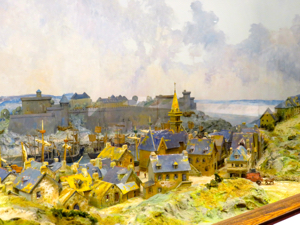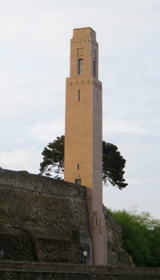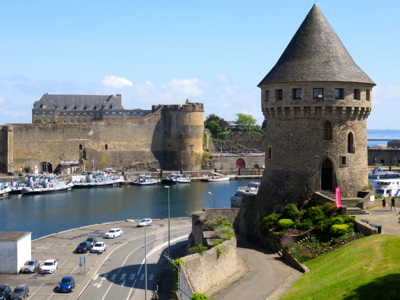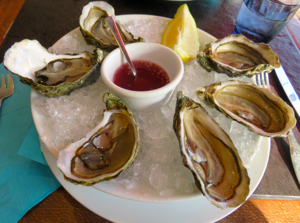 |
Brest, Bretagne, France | |
| Brest is a major port in the northwestern part of Brittany, in the department known as Finistère. | ||
|
|
|
Finistère translates as "land's end" or even "end of the earth." Perched on the shore at the far northwestern end of Brittany (map), Brest can seem far away. But it's only 71 kilometers (44 miles) from Quimper, via the beautiful Crozon Peninsula, and TGV trains from Paris can take you there in as little as five hours. A Modern City...Although Brest has a long history, thanks to its strategic location and heavy bombing during World War II, little remains of its past. The Château on the water provides a glimpse of the past. When you first survey the harbor, you'll understand why Brest has been so important for so long: well "inland" from the tip of the peninsula, its port is a broad, sheltered bay protected from Atlantic sgtorms—and from attackers—by the Crozon Peninsula. ...That's Very OldBrest also has a long naval history since Cardinal Richelieu designated it as a military harbor in 1631. Its two most significant surviving historic buildings are the Château de Brest, the massive protector of the harbor which has been here, in some form, for 1700 years—the oldest fortress in the world still in military use. The Tour de Tanguy, across the channel from the château, dates from the mid-1300s. It now houses a museum of the history of Brest. During World War I, it was an important port for American troops and supplies coming to France in support of the Allies. During World War II, the occupying German navy build an important submarine base here in addition to the port's other uses as a naval harbor and shipbuilding site. Today it is France's second-most important naval port (after Toulon). Maritime commerce the lifeblood of the city. TransportationTrainTGV trains travel between the Gare de Brest SNCF and Paris-Montparnasse in as little as 3-1/2 hours; between Brest and Rennes in a little over two hours. Reserve in advance to get the fastest train. Breizhgo TER regional trains and buses (cars in French) link Brittany's cities and towns. More... AirportAéroport Brest Bretagne (BES; sometimes called Brest-Guipavas) serves internal French flights, and international flights to/from Eire, Greece, Morocco, Portugal and Spain. More... Intercity BusEurolines, Flixbus and Ouibus link Brest with other European destinations by bus. Public TransportationCity Bus, Tram & Cable CarBibus operates Brest's municipal transport network, which includes city buses, a tram line, and the cable car (téléferique) linking Boulevard Jean Moulin on the east shore of the River Penfeld with the Ateliers station on the west shore. More... FerriesPenn Ar Bed, the Breton term for Finistère, is also the name of the ferry company providing links to the islands of Ouessant, Molène and Sein. More... Brest Ouest (or Le Brestoâ) offers a ferry link from Brest to the Crozon peninsula, as well as harbor cruises. More... Where to StayHere's a handy Hotel Search Map of Brest, with prices:
Tourist InformationThe helpful Office de Tourism de Brest métropole is located in the city center at 8 avenue Georges Clemenceau near the Place de la Liberté (map). What to See and DoBrest is a large and modern city, as noted above. There are broad boulevards to walk on, such as the rue de Siam and the enormous Place de la Liberté. The main part of the city is on a hill, and the walk down to the port area is pleasant. Walking back up is a little harder! As you walk up you will see a tall red granite monument overlooking the harbor. The inscription says "Erected by the United States of America to commemorate the achievements of the Naval Forces of the United States and France during the World War." Originally built after World War I, it was destroyed by the Germans in 1941, and rebuilt in 1958. As the westernmost port in France, it was a major embarkation point for the American Expeditionary Forces in 1917-18. The port area has a variety of seafood restaurants, as well as excursion boats that offer several tours of the inner harbor, as well as longer trips to Camaret on the Presqu'Île de Crozon or farther out to several islands off the coast. In town, there are several museums of interest: The National Marine Museum, focusing on Brest's maritime history and housed in the château; the Museum of Fine Arts, whose collection of paintings, sculptures and graphic arts reflect the city's maritime tradition; and the Tour Tanguy. The Tour Tanguy is located in the area known as Recouvrance, the recovery, or safe return to port. A working class, Breton speaking district, Recouvrance has a unique identity and a long history.
The tower itself dates from the 14th century and is assumed to have been part of the fortifications that ensured or prevented communications between the two sides of the Penfeld River. Located directly across from the Château, it offers lovely views of that structure. The city of Brest bought the Tour Tanguy in 1954 and it now serves as a museum of the history of Brest, Musée du Vieux Brest. Dioramas illustrate important events in the city's past. Brest's population today is multinational and multicultural, as illustrated by the vendors at the wonderful open air market on the rue de Lyon. We visited on a Sunday and it was a lively scene, with booths for Breton specialties as well as offerings of Brazilian, Arabic, African and other foods. In addition, vendors offered clothing, leather goods, household equipment, and more. And speaking of food, this area of Brittany is known for its delicious strawberries, many of which come from the Plougastel Peninsula, just about 15 minutes east of Brest. We were there in June and took full advantage of the lovely offerings.
|
|
Above, Château de Brest, still a naval fortress.

|




